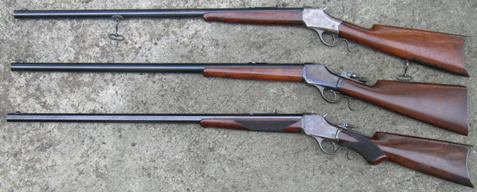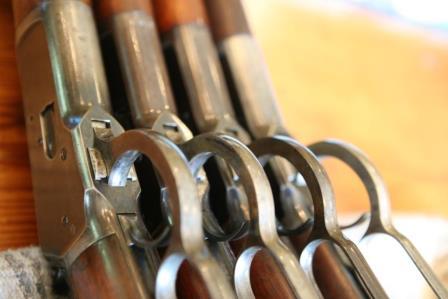Perhaps this is addressed in the 4th Edition of the Red Book. I intend to order a copy later next week…
BUT…how does one grade a SRC from the teens in which 90% of the bluing remains, except for the barrel band and receiver, which is grey? It was common in this era for a SRC to appear as described, with use.
One described as such recently sold for $1600 plus shipping, which, working backwards using the (heavily flawed) Blue Book…suggests that a retail sale in this price range suggests an overall condition of between 60 and 70 %, once one adds in the 40% premium for calibers other than .30 WCF and .32 Special. The one referenced was in .32-40, and I believe the wood may have been refinished, even though the ad did not state as such.
I would grade it somewhere in the 40-50% range, and the $1,600 sale price is almost exactly what it should have sold for being that it was a 32-40. Refinished wood would lower the graded condition to 30% or less, and reduce the value to approximately $1,200.
Bert
WACA Historian & Board of Director Member #6571L

Hello,
This is written with no intended disparagement toward Bert or the Red Book. But rather is just food for thought.
Trying to accurately judge and determine the graded condition of rifles based on the often few and/or poor photographs associated with most auctions is an extremely difficult chore and I would suggest that there is a wide error bar for any rifle. I have seen many rifles resold and photographed by different people under different circumstances and methods and the rifles look amazingly different from one example to another. Therefore, the perceived “correct value” for a specific graded condition range is going to also have a range of error. If you also then take into account that a significant number of rifles are bought at auction by well known dealers, who then mark them up 20 to 40%, and (we) collectors happily buy from them the same rifle at a “premium” price which only adds to the fuzziness of a correct value per graded condition. Valuation books should be used as a guide and we should recognize the inherent plus or minus range for any number that is contained within them.
Respectfully
Michael

Model 1892 / Model 61 Collector, Research, Valuation
I really wish a standard grading of Bluing could be devised and implemented. Certainly now it is all over the map.
Sellers now grading 80% is sometimes seen as blue under perfect low light conditions. In reality it is extremely thin and add a little light and it appears as pure rust. In reality is less than 10% of the amount of blue that came on the new gun
I consider 100% to be a brand new gun in the store (thick fully colored blue under any light condition ) and wish that this could be quantified so that a grading system of actual % Blue REMAINING of this could be known and honestly quoted
I am meaning the 100 yr old+ guns . the post WW II guns often still have thicker Blue
Phil

twobit said
Hello,This is written with no intended disparagement toward Bert or the Red Book. But rather is just food for thought.
Trying to accurately judge and determine the graded condition of rifles based on the often few and/or poor photographs associated with most auctions is an extremely difficult chore and I would suggest that there is a wide error bar for any rifle. I have seen many rifles resold and photographed by different people under different circumstances and methods and the rifles look amazingly different from one example to another. Therefore, the perceived “correct value” for a specific graded condition range is going to also have a range of error. If you also then take into account that a significant number of rifles are bought at auction by well known dealers, who then mark them up 20 to 40%, and (we) collectors happily buy from them the same rifle at a “premium” price which only adds to the fuzziness of a correct value per graded condition. Valuation books should be used as a guide and we should recognize the inherent plus or minus range for any number that is contained within them.
Respectfully
Michael
Well said and good information Michael.
I am very thankful to have a book that has data derived from actual sales, and an average of the price points. The Red Book is the only factually based value indicator published to the degree it has in it.
Applying Michael’s comments, with Red Book valuations, gives a good groundwork for all collectors and buyers with other purchase reasons.
Kudos to Larry and Bert for their contribution to collecting and buying Winchesters !!
Bill
August 11, 2015
 Offline
OfflineAll, I really struggle with the % blue notion. Might be the “engineer” in me, but it seems that 90% can only translate to 40-50% if either the 90% is incorrect or if the percentage of blue has a percentage to it as well. Kind of like where the thickness of the bluing comes into play?
Forgive me for dwelling on these issues but am on last day of vacation and looking for something to start stressing about. Wish I could have made it to Cody to ask some of these types of questions in persons, but had other matters that to tend. Regards.
This is a very worthwhile subject, IMO. Some gun pictures are so great nowadays that a percentage grade of the metal and wood condition is moot, but when the percentage of finish of the metal and wood does accompany such quality pictures, along with an accurate detailed description of same, the latter should go a long way in supporting the conclusions that readers would draw themselves.
Here’s two Winchester Model 1890 rifles that are up for auction on GunBroker that might act as learning tools for interested parties should a valuable discussion ensue:
1 – “Overall condition is very good with 85% of the original untouched factory finish remaining.”
http://www.gunbroker.com/item/574322922
2 – “Overall condition is fine to excellent with 95+% of the original untouched factory finish.”
http://www.gunbroker.com/item/574331784
James
August 11, 2015
 Offline
OfflineHere is my take:
1) This looks to me to have some overall thinning of the blue on the receiver and barrel/magazine. In addition, it looks like a bit of rust showing thru on the barrel in a couple of pictures. The receiver has some good spots but a bit bare in areas. I would rate this as a 45% to 50% at best.
2) A much brighter blue image on the barrel and no perceivable rusting. Receiver has some spots but generally looks similar to the barrel. I would rate this as a 75%.
Regards,
November 7, 2015
 Offline
OfflineI thought I was being a bit pessimistic in my ratings when I first read this post last night, maybe not. It may have been the lighting but I feel the bluing was pretty thin on both rifles and therefore felt they were both significantly overrated. High spots and other areas showed significant wear on both rifles. My newbie assessment was 60 and 70% but I suspect seeing them in person could change that. In all honesty I suspect I generally rate a bit low but I’m generally a buyer these days, not a seller.
When I first started selling guns I looked at just about every grading scale you could think of. What I finally settled on was “% of original blue remaining “. As long as the wood matches the metal in wear, which it should if the gun is honest, then its a good solid gauge. The only real problems I’ve ever had are those “flaked” Winchesters, Colts and Smiths. It hurts to rate a 1918 SRC at 70% when you can tell it hasn’t been fired 100 times. So I try to make sure those guns get extra pics and description if necessary.
Mike(Two Dogs and a Gun)
Grading the percentage of remaining blue, only, seems to be a very popular method that is used by a lot of folks, including some appraisers at the large auction houses too. Me, I just try to determine how the seller has arrived at their description, and whether or not I agree with it for the most part. I have used that method as well when selling.
Added:
Mike, I totally agree with your comments regarding the wood matching the metal wear…great point to make in helping to determine condition. I also agree with your comments about flaking. I have witnessed on numerous occasions where well known dealers ignore, to a large degree, some Winchesters that have severely flaked receivers, but excellent finish on most of the metal and wood, and price them somewhat accordingly to that end. I’m good with that to some extent.
James
Here is another example of a Winchester Model 1890 that might be interesting to a lot of parties, especially where the rifle has a very clean look, and what might be considered a low price for the amount of bluing and wood finish that remains:
http://www.gunbroker.com/Item/575463791
James
1 Guest(s)


 Log In
Log In Members
Members Home
Home

 Add Reply
Add Reply Add Topic
Add Topic





